
The Auger effect or Auger−Meitner effect is a physical phenomenon in which the filling of an inner-shell vacancy of an atom is accompanied by the emission of an electron from the same atom. When a core electron is removed, leaving a vacancy, an electron from a higher energy level may fall into the vacancy, resulting in a release of energy. For light atoms (Z<12), this energy is most often transferred to a valence electron which is subsequently ejected from the atom. This second ejected electron is called an Auger electron. For heavier atomic nuclei, the release of the energy in the form of an emitted photon becomes gradually more probable.

An impact crater is a depression in the surface of a solid astronomical body formed by the hypervelocity impact of a smaller object. In contrast to volcanic craters, which result from explosion or internal collapse, impact craters typically have raised rims and floors that are lower in elevation than the surrounding terrain. Impact craters are typically circular, though they can be elliptical in shape or even irregular due to events such as landslides. Impact craters range in size from microscopic craters seen on lunar rocks returned by the Apollo Program to simple bowl-shaped depressions and vast, complex, multi-ringed impact basins. Meteor Crater is a well-known example of a small impact crater on Earth.

Lise Meitner was an Austrian-Swedish physicist who was one of those responsible for the discovery of the element protactinium and nuclear fission. While working on radioactivity at the Kaiser Wilhelm Institute of Chemistry in Berlin, she discovered the radioactive isotope protactinium-231 in 1917. In 1938, Meitner and her nephew, the physicist Otto Robert Frisch, discovered nuclear fission. She was praised by Albert Einstein as the "German Marie Curie".

Meteor Crater, or Barringer Crater, is an impact crater about 37 mi (60 km) east of Flagstaff and 18 mi (29 km) west of Winslow in the desert of northern Arizona, United States. The site had several earlier names, and fragments of the meteorite are officially called the Canyon Diablo Meteorite, after the adjacent Canyon Diablo.

The Chicxulub crater is an impact crater buried underneath the Yucatán Peninsula in Mexico. Its center is offshore, but the crater is named after the onshore community of Chicxulub Pueblo. It was formed slightly over 66 million years ago when a large meteorite, about ten kilometers in diameter, struck Earth. The crater is estimated to be 200 kilometers in diameter and 20 kilometers in depth. It is the second largest confirmed impact structure on Earth, and the only one whose peak ring is intact and directly accessible for scientific research.

Pasteur is a large lunar impact crater, approximately 233 kilometers in diameter, belonging to the category termed a walled plain. It was named after French chemist and microbiologist Louis Pasteur. It lies on the far side of the Moon as seen from the Earth, just beyond the eastern limb. The vicinity of this crater is occasionally brought into view from Earth due to librations, although not much detail can be seen.

Lunar craters are impact craters on Earth's Moon. The Moon's surface has many craters, all of which were formed by impacts. The International Astronomical Union currently recognizes 9,137 craters, of which 1,675 have been dated.
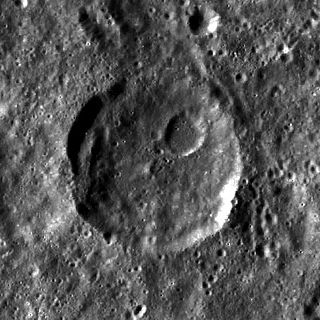
Khvolʹson is a crater on the far side of the Moon. It lies just to the east-southeast of the large walled plain Pasteur. Less than a crater diameter to the north-northeast of Khvolʹson is the crater Meitner, and just to the east-southeast lies Kondratyuk.
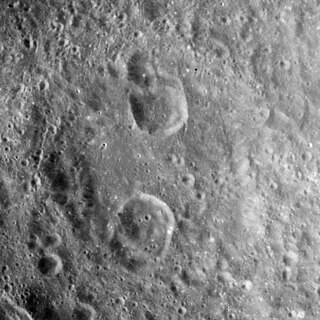
Kondratyuk is a worn crater on the Moon's far side. It is located to the west-northwest of the large walled plain Fermi, and to the northeast of the crater Hilbert. To the north-northwest is Meitner, and to the northeast lies Langemak.
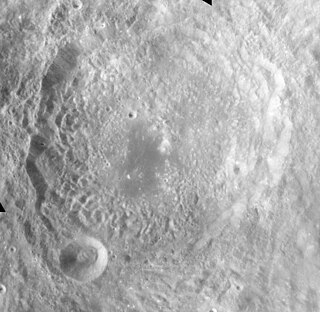
Langemak is a prominent impact crater on the far side of the Moon. It is located less than one crater diameter west-northwest of Danjon, and nearly due east of Meitner. To the southwest of Langemak is Kondratyuk. Langemak partly overlies the larger and older crater Langemak N. This feature is also attached to the northeastern rim of Kondratyuk.

Meitner is an impact crater on the far side of the Moon, behind the eastern limb. It lies to the northwest of the crater Kondratyuk, and about a crater diameter to the west of Langemak.
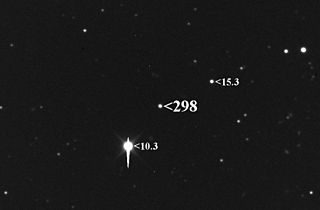
The Baptistina family is an asteroid family of more than 2500 members that was probably produced by the breakup of an asteroid 170 km (110 mi) across 80 million years ago following an impact with a smaller body. The two largest presumed remnants of the parent asteroid are main-belt asteroids 298 Baptistina and 1696 Nurmela. The Baptistina family is part of the larger Flora clan. It was briefly speculated that the Chicxulub impactor was part of the Baptistina family of asteroids, but this was disproven in 2011 using data from the Wide-field Infrared Survey Explorer (WISE).
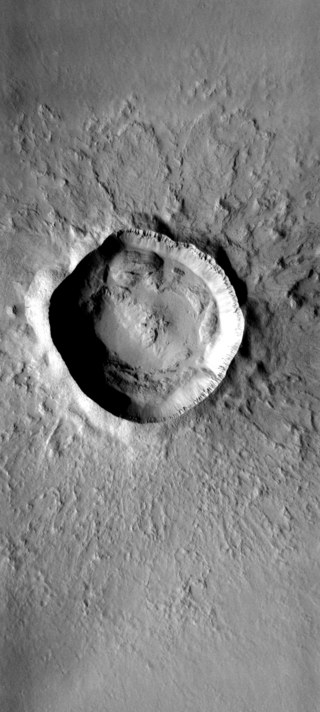
Zunil is an impact crater near the Cerberus Fossae on Mars, with a diameter of 10.26 kilometres. It is named after the town of Zunil in Guatemala. The crater is located in the Elysium quadrangle. Visible in images from the Viking 1 and Viking 2 Mars orbiters in the 1970s, Zunil was subsequently imaged at higher resolution for the first time by the Mars Global Surveyor (MGS) Mars Orbiter Camera (MOC) in 2000.
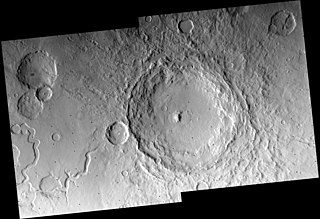
Cerulli is a crater in the Ismenius Lacus quadrangle on Mars with a diameter of 130 km. It lies in the northern hemisphere south of the very large crater Lyot. It is named after Vincenzo Cerulli, an Italian astronomer (1859–1927).
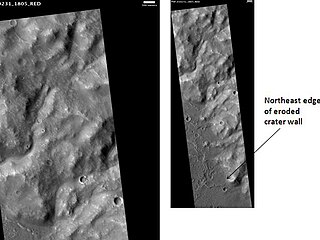
Escalante Crater is an impact crater in the Amenthes quadrangle of Mars. It is located at 0.2° N and 244.7° W. It is 79.3 km (49.3 mi) in diameter, and was named after Mexican astronomer Francisco Javier Escalante Plancarte.

Puńsk is an impact crater on Mars, located in the Oxia Palus quadrangle at 20.8° N and 41.2° W. It measures 11.6 kilometers in diameter and was named after the village of Puńsk in Poland.
Meitner may refer to the following:
A peak ring crater is a type of complex crater, which is different from a multi-ringed basin or central-peak crater. A central peak is not seen; instead, a roughly circular ring or plateau, possibly discontinuous, surrounds the crater's center, with the crater rim still farther out from the center.
















